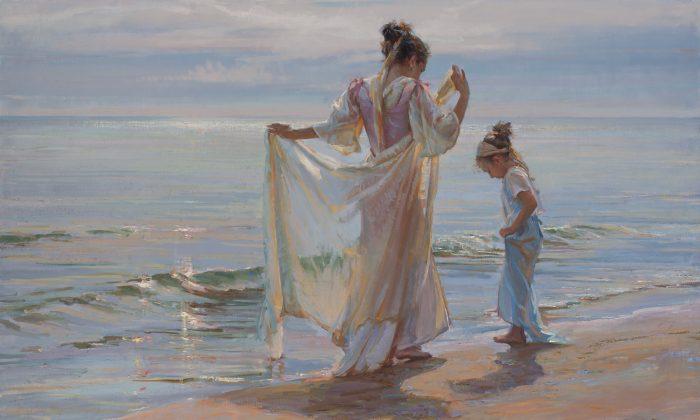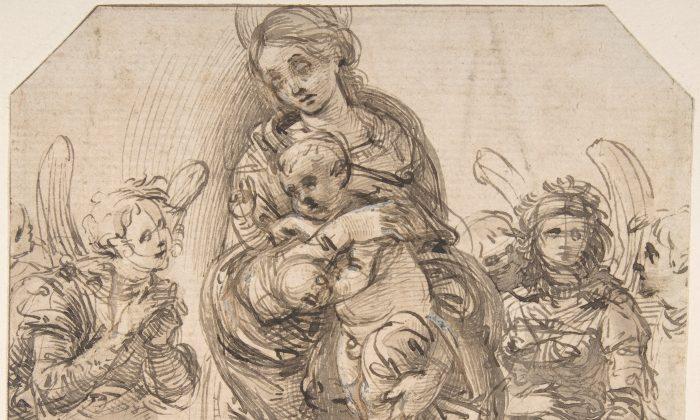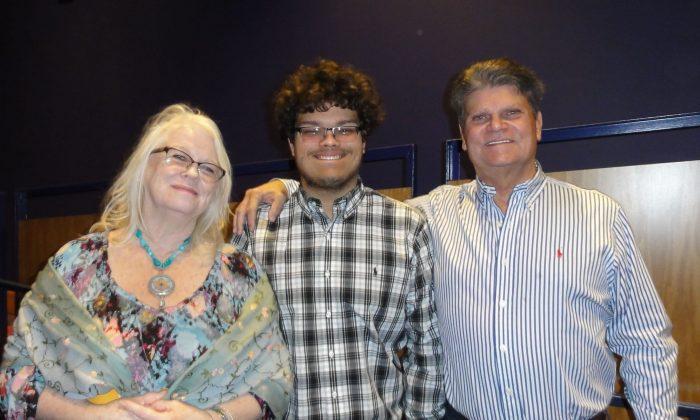KEWASKUM, Wisc.—Taped to Daniel Gerhartz’s easel is a sticky note saying “squint down.”
The note reminds him to squint his eyes in order to simplify the image and be less overwhelmed by the complexities of the image and color when he paints from life.
Observing his loose yet precise brushstrokes, one can immediately identify John Singer Sargent as an influence, but unlike the Gilded Age master, Gerhartz imbues figures with something irresistibly spiritual, a quality that his admirers can’t help but remark upon.
Gerhartz is approaching his 50s, but looks like he’s in his 30s. Tall and thin, he speaks clearly, poetically, and humbly.
“There are subtleties that happen, nuances that you can’t predict,” Gerhartz said of painting from life. “There are edges and value shifts that you see more clearly. To show the subtlety, the form, the anatomy, everything all at once, you have to see it from life. It’s when you start making it up that it throws it off.”
Originally a graphic designer, Gerhartz began his career as an artist over 25 years ago and studied at the American Academy of Art in Chicago. He studied under Richard Schmid, a renowned oil painter and the mentor to many successful portraitists working today.
Gerhartz’s work has won critical acclaim internationally. He gives workshops and demonstrates his techniques in several instructional videos and has recently published a catalog of his works, “Not Far From Home.”
At his studio tucked in the rolling hills of Kewaskum, Wisc., Gerhartz showed me around and explained his process.
In the Brushstrokes
“It’s paying attention to how light spins forms,” he said.
But that’s just the basic principle of any realism.
Gerhartz’s simplification of forms requires foresight and decision-making at the inception of every brushstroke—when to stay true to what he sees, and when to take liberties.
“There is a point in the painting where I’m slavishly realistic but there’s a point towards the end where I have to look at it more poetically,” he said.
Gerhartz has developed a unique style characterized by thick brush strokes and simplified forms. Working on a still-life, he swirled his brush over the palette and finished painting a daffodil petal. He showed me how a few brushstrokes could achieve the desired result, noting that the shadow from an overlapping petal cast a warm color on the one he was painting.
“Keep it simple,” he said as he dipped his brush again, adding the finishing touches to the flower.
In a painting of his daughter Sophie, a swooping swirl of dark red umber on the far corner curved back into the portrait, swinging the viewer’s eyes back to the central figure. The red flowers on Sophie’s dress and the colors were repeated in the negative space surrounding her. The end result is a vivid portrait that held the attention.
Meaning and Mercy
Gerhartz’s pastoral settings portray a calm, reflective, and communal world. Benevolence, trust, and hopefulness comes through in his multi-figure works. Using the countryside and rural landscapes gives a sense of a simpler life one may wish for but so often cannot find.
His painting “Compassion” is a prime example of how Gerhartz balances his compositions with color and form. A young woman in a dark dress is lost in reverie, her head drooped. Another woman supports her hand. Vases of wilting pink roses reiterate the tender care one girl silently shows to the other.
Like all work that requires emotional dedication, creating art imbued with this deep sense of humanity takes frequent reaffirmation.
“It’s not always easy when you are in your studio or painting and you question everything: ‘What am I doing this for? I should be out doing something else,’ but this is what I’m called to do.”
“Beauty carries the message,” he said. “Mercy, love and forgiveness are right here in the created world we live in. If I can capture it, just a bit of the beauty of it, that message carries through.”
“I can’t consciously put that message in there. If I try to force it in, it probably won’t make it,” he reflected. “But if I simply try to tell the truth, then the message of hope will come in through the back door. Something bigger will use it.”
Daniel Gerhartz’s website is danielgerhartz.com. Tim Gebhart is an artist residing in Menasha, Wisc.






Friends Read Free